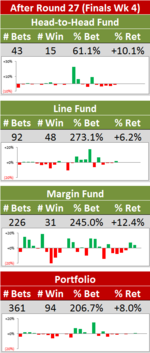A Paradox, Perhaps to Ponder
 Thursday, March 11, 2010 at 9:18PM
Thursday, March 11, 2010 at 9:18PM Today a petite blog on a quirk of the percentages method that's used in AFL to separate teams level on competition points.
Imagine that the first two rounds of the season produced the following results:

Geelong and St Kilda have each won in both rounds and Geelong's percentage is superior to St Kilda's on both occasions (hence the ticks and crosses). So, who will be placed higher on the ladder at the end of the 2nd round?
Commonsense tells us it must be Geelong, but let's do the maths anyway.
- Geelong's percentage is (150+54)/(115+32) = 138.8
- St Kilda's percentage is (75+160)/(65+100) = 142.4
How about that - St Kilda will be placed above Geelong on the competition ladder by virtue of a superior overall percentage despite having a poorer percentage in both of the games that make up the total.
This curious result is an example of what's known as Simpson's paradox, a phenomenon that can arise when a weighted average is formed from two or more sets of data and the weights used in combining the data differ significantly for one part compared to the remainder.
In the example I've just provided, St Kilda's overall percentage ends up higher because its weaker 115% in Round 1 is weighted by only about 0.4 and its much stronger 160% in Round 2 is weighted by about 0.6, these weights being the proportions of the total points that St Kilda conceded (165) that were, respectively, conceded in Round 1 (65) and Round 2 (100). Geelong, in contrast, in Round 1 conceded 78% of the total points it conceded across the two games, and conceded only 22% of the total in Round 2. Consequently its poorer Round 1 percentage of 130% carries over three-and-a-half times the weight of its superior Round 2 percentage of 169%. This results in an overall percentage for Geelong of about 0.78 x 130% + 0.22 x 169% or 138.8, which is just under St Kilda's 142.4.
When Simpson's paradox leads to counterintuitive ladder positions it's hard to get too fussed about it, but real-world examples such as those on the Wikipedia page linked to above demonstrate that Simmo can lurk within analyses of far greater import.
(It'd be remiss of me to close without noting - especially for the benefit of followers of the other Aussie ball sports - that Simpson's paradox is unable to affect the competition ladders for sports that use a For and Against differential rather than a ratio because differentials are additive across games. Clearly, maths is not a strong point for the AFL. Why else would you insist on crediting 4 points for a win and 2 points for a draw oblivious, it seems, to the common divisor shared by the numbers 2 and 4?)
 TonyC |
TonyC |  Post a Comment |
Post a Comment | 

Reader Comments